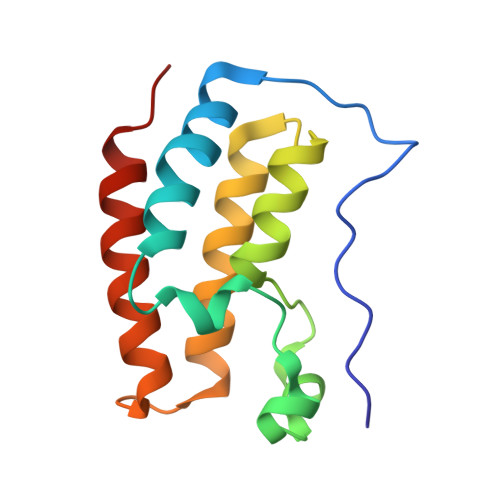Protein-Protein Interaction Inhibition (2P2I)-Oriented Chemical Library Accelerates Hit Discovery.
Milhas, S., Raux, B., Betzi, S., Derviaux, C., Roche, P., Restouin, A., Basse, M.J., Rebuffet, E., Lugari, A., Badol, M., Kashyap, R., Lissitzky, J.C., Eydoux, C., Hamon, V., Gourdel, M.E., Combes, S., Zimmermann, P., Aurrand-Lions, M., Roux, T., Rogers, C., Muller, S., Knapp, S., Trinquet, E., Collette, Y., Guillemot, J.C., Morelli, X.(2016) ACS Chem Biol 11: 2140-2148
- PubMed: 27219844
- DOI: https://doi.org/10.1021/acschembio.6b00286
- Primary Citation of Related Structures:
5DLX, 5DLZ - PubMed Abstract:
Protein-protein interactions (PPIs) represent an enormous source of opportunity for therapeutic intervention. We and others have recently pinpointed key rules that will help in identifying the next generation of innovative drugs to tackle this challenging class of targets within the next decade. We used these rules to design an oriented chemical library corresponding to a set of diverse "PPI-like" modulators with cores identified as privileged structures in therapeutics. In this work, we purchased the resulting 1664 structurally diverse compounds and evaluated them on a series of representative protein-protein interfaces with distinct "druggability" potential using homogeneous time-resolved fluorescence (HTRF) technology. For certain PPI classes, analysis of the hit rates revealed up to 100 enrichment factors compared with nonoriented chemical libraries. This observation correlates with the predicted "druggability" of the targets. A specific focus on selectivity profiles, the three-dimensional (3D) molecular modes of action resolved by X-ray crystallography, and the biological activities of identified hits targeting the well-defined "druggable" bromodomains of the bromo and extraterminal (BET) family are presented as a proof-of-concept. Overall, our present study illustrates the potency of machine learning-based oriented chemical libraries to accelerate the identification of hits targeting PPIs. A generalization of this method to a larger set of compounds will accelerate the discovery of original and potent probes for this challenging class of targets.
Organizational Affiliation:
CNRS, INSERM, Aix-Marseille Université, Institut Paoli-Calmettes, Centre de Recherche en Cancérologie de Marseille , CS30059, 13273 Marseille Cedex 9, France.















